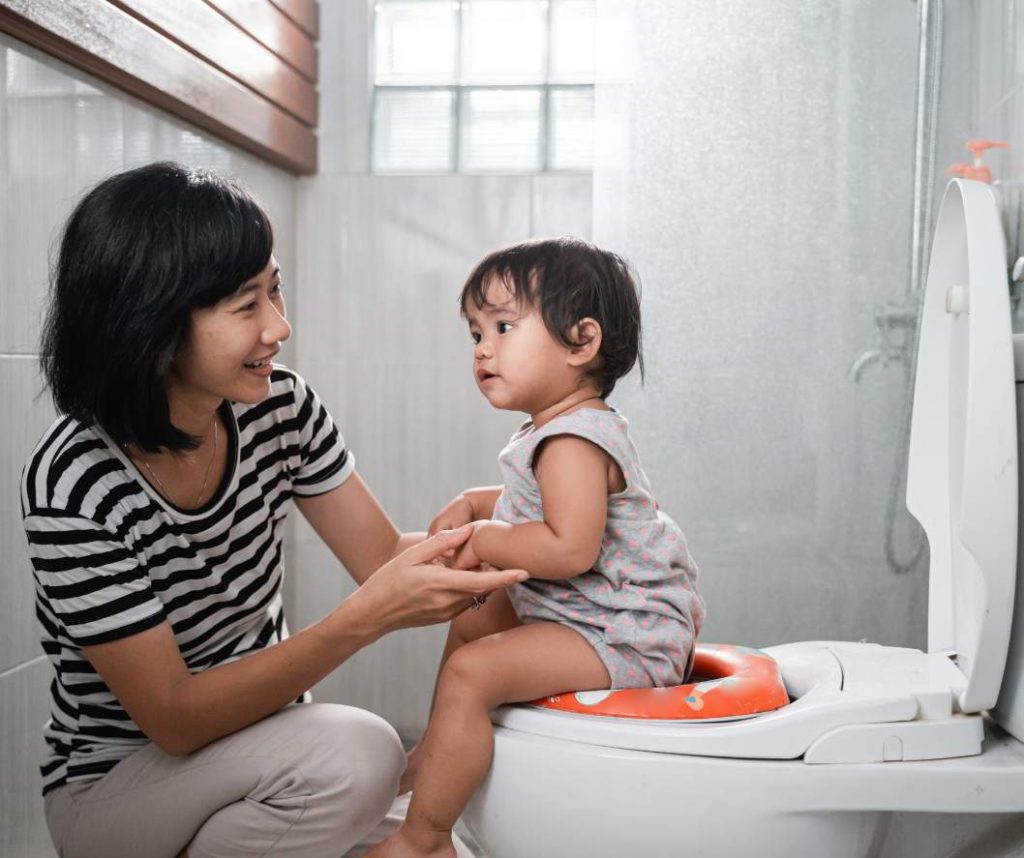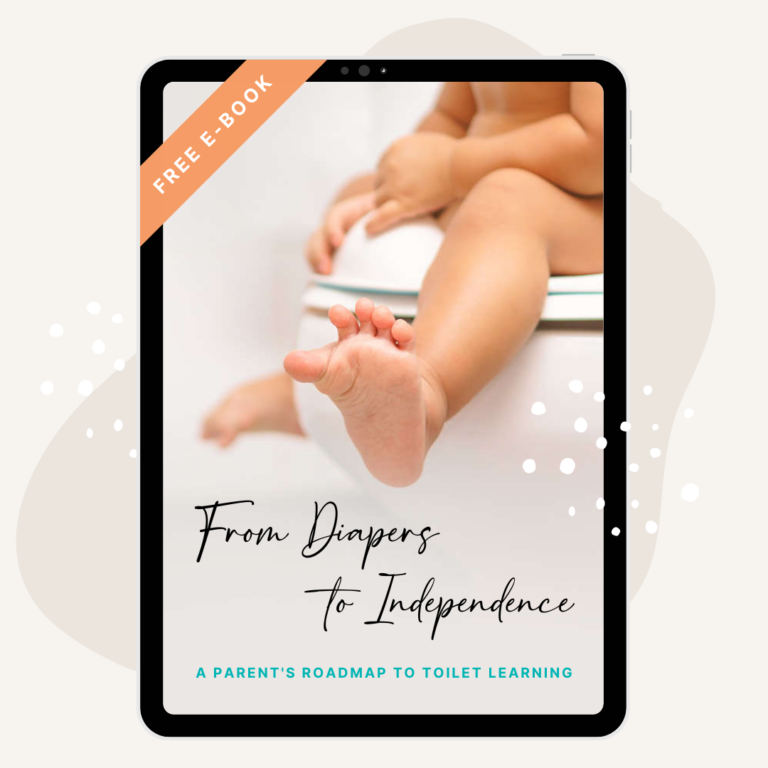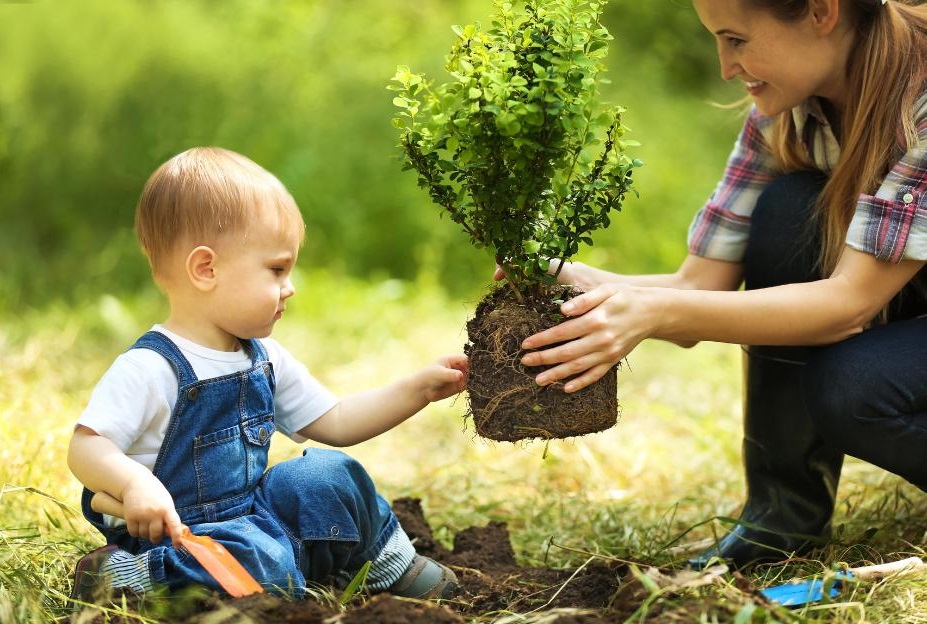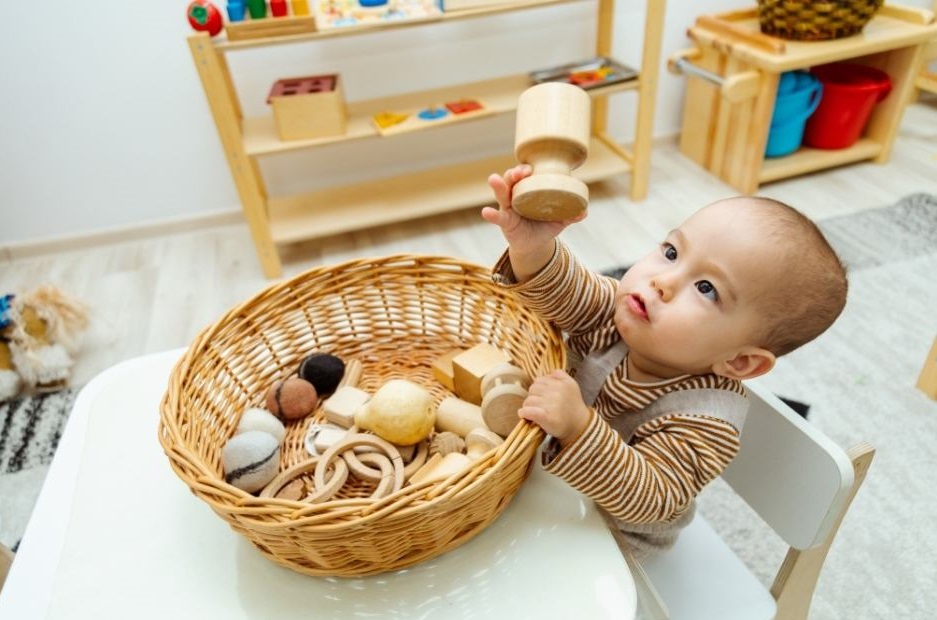“Learning to use the toilet is a natural process that begins when your child’s desire to be grown up and his neurological development have reached the point where he can control his bladder and bowels. We don’t train children to use the toilet, we support them when they are ready.”
– Tim Seldin, How to Raise an Amazing Child The Montessori Way
A natural, gradual developmental process
The Montessori approach to toilet learning is a very natural, gradual process closely attuned to a child’s readiness and desire for engaging in the process. It is a developmental skill that children acquire independently over time, not an activity that requires training. Toileting is a journey that facilitates teamwork between the child and the adult through which parents can support their child by observing their needs and behaviors, preparing the environment, and providing encouragement and support. The adult can prepare the environment and themselves for this journey, remaining committed and consistent as they assist the child in their natural development.
Here are the 10 top tips for toilet learning we recommend:
1. Allow it to occur naturally
When it comes to our children, it can sometimes be really hard to remain impartial. When it comes to toilet learning, try to allow the process to develop naturally. Provide support and encouragement, but try not to have specific expectations.
Since disposable diapers keep children so dry, it can be helpful for your child to wear underwear as much as possible so they can begin to notice the different sensations of being wet, dry, and soiled. They will likely begin to realize it feels better to be clean and dry and will begin gradually holding their bladder for longer periods.
If you get resistance from your child about toileting, remain calm and reassuring. Never force a child to use the toilet.
2. Facilitate physical development
Helping the child develop independence with self-care activities including dressing and undressing themselves supports toilet learning.
- Model how to put on and take off clothing with slow, deliberate movements.
- Sportscast what you’re doing as you help your child to dress and undress themselves.
- Hang a mirror at your child’s eye-level so they can see the body movements necessary for dressing and undressing.
- Choose loose fitting clothing items that are easier for children to put on and take off independently. Shorts and pants with elastic waistbands are easily accessible. Try to avoid multiple layers and dresses, skirts, or overalls as they are difficult to remove and hold up during toileting. Remember that zippers and buttons can be challenging for little ones.
3. Normalize the toileting process
Toileting is a normal process and we can explain to our children that everyone needs to use the toilet to get rid of parts of the food our bodies don’t need. Try to refrain from conveying disgust by describing toileting as yucky or by holding your nose. Invite the child to join you in the bathroom to watch the toileting process. Help the child recognize their own body signals, stating nonverbal signals subjectively, “I notice that you’re crossing your legs. I wonder if you need to urinate.”
4. Provide a prepared environment
It is important to set up the bathroom space in a way that supports the child’s independence with toileting. It doesn’t need to be picture-perfect or Instagram worthy, just intentional; think child height and child friendly. Here are some items that it will be helpful to have in the bathroom to support the child’s growing independence with toileting:
- Child-size toilet or steps to access the toilet without assistance and a toilet insert
- Step stool for the sink and vanity
- Small hand towel at the child’s height
- Rags for clean-up
- Bin for wet or soiled clothing
- Basket of clean clothing and undergarments
5. Establish a consistent toileting routine
Try to ensure that all caregivers use the same method and routine. Observing your child’s natural bladder and bowel movements and encouraging the use of the toilet at these times can be helpful. Look for nonverbal cues and behaviors that your child needs to go to the toilet as well. It is also a good idea to offer the toilet before and after activities including car rides, outdoor play time, lunch, and nap time.
You can also promote independence in establishing a routine with the use of a visual timer that signals to the child when it is time to use the toilet. Try not to interrupt the child when they are playing or concentrating; wait until they are between activities to offer the toilet.
Shift from frustration and challenges to opportunities for growth and confidence in your child’s toilet learning journey thanks to our Parent’s Roadmap to Toilet Learning the Montessori way.
6. Use kind, but clear language
Instead of asking the child if they’d like to use the toilet, try using kind, clear language such as “It’s time to use the toilet” or “When you finish that activity, it is time to go to the toilet.” This reduces the likelihood of a power struggle and eliminates the option to decline an invitation.
7. Offer choices
Any time you can offer a child a choice, they will feel more motivated. When it is time to use the toilet, offer the child a choice so they feel a sense of autonomy in the process. Ask them things like, “Would you like to use the big toilet or your potty?” or “Would you like to hop to the bathroom or walk on your tiptoes?” Offering choices in this way engages cooperation.
8. Avoid pressure or reward
Our goal is for the child to develop this intrinsic motivation and pride that comes from developing toileting independence. Going to the toilet is a normal activity and should be communicated that way to children.
Avoid clapping and celebrating. These external rewards are likely to make a child feel more anxious and experience feelings of disappointment when they have an accident.
Instead, allow children to experience the rewards that naturally come with the toileting process like flushing the toilet and washing their hands. Although these activities might not seem like rewards to us as adults, to a child asserting their independence, they’re huge.
9. Be prepared for occasional accidents and setbacks and respond calmly
It is important to have realistic expectations; accidents will happen. When these accidents do occur, try to remain calm and reassuring. Try to ensure the child doesn’t feel ashamed. State what you see, “I see you are wet. Let’s go get some dry clothes.”
10. Setbacks/Regression
Certain life events including the birth of a new sibling, moving, starting a new school, vacations, and disruptions to a child’s daily routine can cause setbacks to toilet learning. Typically, these regressions will resolve themselves when parents or caregivers offer calm support.
Remember that toileting is a gradual process that will require teamwork. Aid your child with patience and calm, remaining committed and consistent. Initially your child will need more assistance as toileting is a multifaceted activity. Provide them the guidance they need, gradually fading this support over time as their confidence and capability develops. Trust in the process and in the child’s ability, allowing them time and space to navigate their toileting journey.






